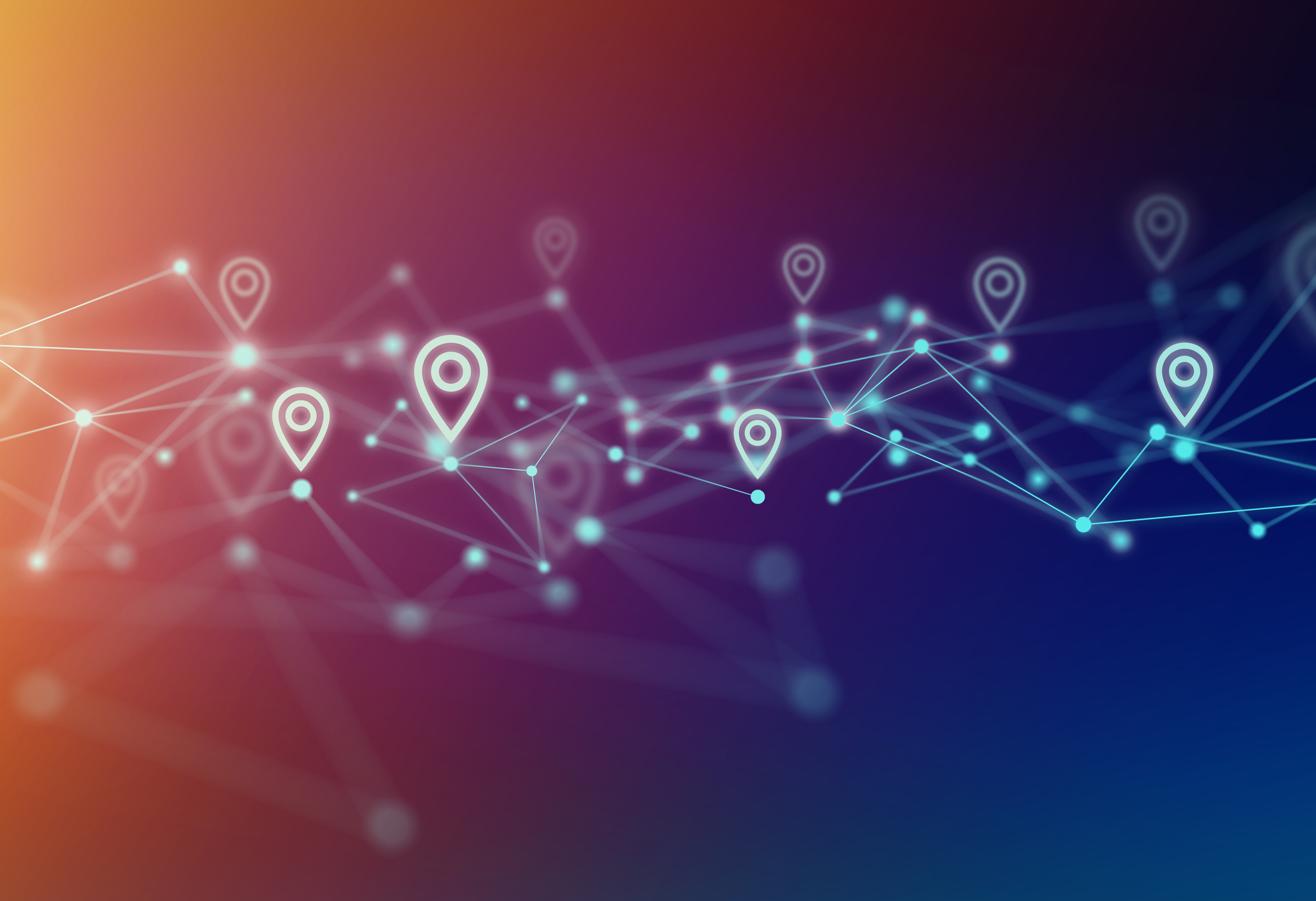When it comes to healthcare website design, it can be hard to stand out today. Design is important — you need to represent your brand. But it’s about more than design, and today’s marketers must consider everything from user experience to load times on mobile devices.
Check out these recent examples of hospital websites, content marketing hubs, landing pages, and blogs that received recognition for visual design, user experience, and technical development.
2022 Award-Winning Healthcare Websites
You name it, our clients won awards for it this year. Custom location landing pages, content marketing hubs, patient-focused content, digital marketing campaigns, site designs and more. Check out some of the best 2022 healthcare websites.
Montage Health
Montage Health, in Monterey, CA, turned to Geonetric to enhance its content efforts with a new content marketing hub. Geonetric built the new content marketing hub with a design that coordinates with Montage Health’s brand and brings its quality content to life.
Since launching in November 2021, the new content marketing hub has seen an impressive increase in clicks from organic search engine results pages and organic search impressions. The site won an eHealthcare Gold award for Best Landing Page or Microsite, as well as Platinum MarCom award for Microsite.
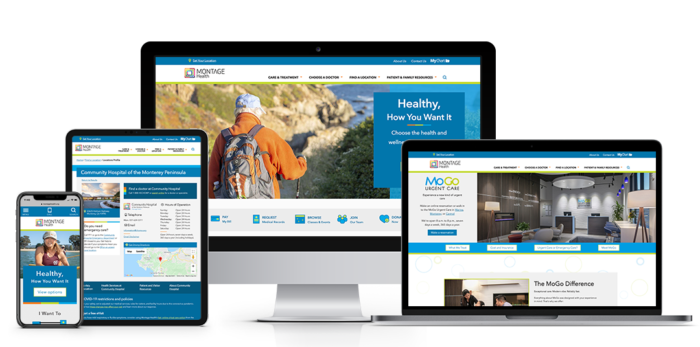
SightMD
SightMD began in Long Island, and now has expanded to 40 locations throughout New York to provide patient first, state-of-the-art eye care. They wanted to rebrand and create a new website that reflected its growth, unparalleled vision services, and patient care approach. SightMD turned to Geonetric to be their new website developer. Geonetric led their content and design strategy for their revamped new digital experience on our easy-to-use platform, VitalSite.
SightMD needed to create brand awareness and grow patient acquisition for all SightMD states. Geonetric’s content strategists created a scalable site navigation that easily accommodates regional expansion to different states and allows users to access all the services, doctors, and locations from the main SightMD homepage.
The new site took home two eHealthcare awards: Gold for Best Site Design & Platinum for Best Overall Internet.
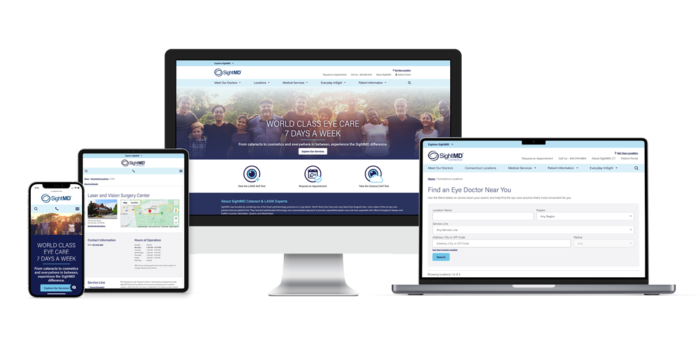
EvergreenHealth
To spread the word about its advances in the delivery of orthopedic services, and to be recognized for its clinical expertise, EvergreenHealth in Kirkland, WA partnered with Geonetric for a redesign and content overhaul.
Geonetric gave the site a modern look that reflects the health system’s cutting-edge care and increases their brand recognition for their clinical expertise. Seventy pages of extensive, patient-friendly content about orthopedic and sports medicine services were created by Geonetric’s content strategists and writers. Since the added content was published, traffic and user engagement has steadily risen.
In the first full quarter after the new site launched, EvergreenHealth saw improvements on many metrics, including total site sessions, organic traffic, pages per session, and bounce rate, as well as an increase in provider profile sessions. For this the site won:
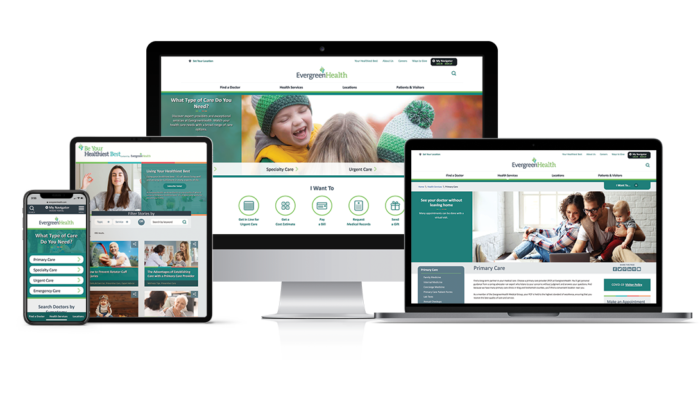
Faith Regional
Faith Regional Health Services is a faith-based healthcare system in Norfolk, Nebraska. With target audiences searching for healthcare services on the go, Faith Regional wanted a website with a mobile-first design. Partnering with Geonetric, they redesigned the site for mobile users. Their new digital landscape provides mobile users with responsive and streamlined sitewide navigation, a layout that follows trends in mobile UX, and new functionality that uses geographic targeting for personalization. The site won an eHealthcare silver award for Best Mobile Website.
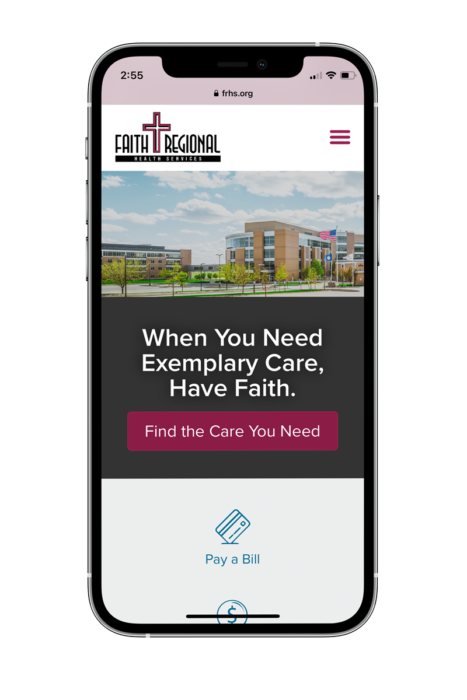
Cone Health
Cone Health is a not-for-profit healthcare network serving people in several counties in central North Carolina. As part of its employee recruitment efforts, the organization partnered with Geonetric on building an engaging, user-friendly website designed to highlight the benefits of working at Cone Health and make it easy to find a position and apply. The health system also wanted the microsite to support staff retention by providing resources for current employees to advance their careers.
Geonetric’s writers and designers created a new engaging and accessible microsite with streamlined navigation and content. Because Cone Health wanted the new site to target current employees as well as job candidates, Geonetric recommended moving employee benefit and wellness information from the health system site into the careers microsite. Both prospective and current employees now can visit just one site for all the information they need to manage each phase of their Cone Health career.
In the first quarter after the site launched, sessions nearly doubled, increasing 93%. The new job category pages are among the highest-viewed content and some of the biggest drivers of clicks to the job search page. This site won an Honorable Mention MarComm award for Microsite.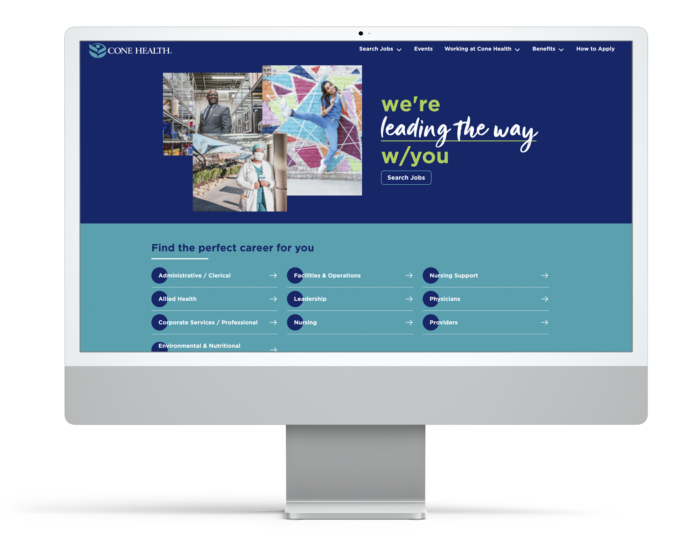
2021 Award-Winning Healthcare Websites
The 2021 healthcare award-winners all let digital strategy take the leading role in meeting their users’ expectations and top their competitions. Read on for more details.
University Health
University Health, in San Antonio and Bexar County, Texas, launched a new website that delivers personalized content to target audiences and builds its brand as an academic health system.
The site, built on Sitecore, won:
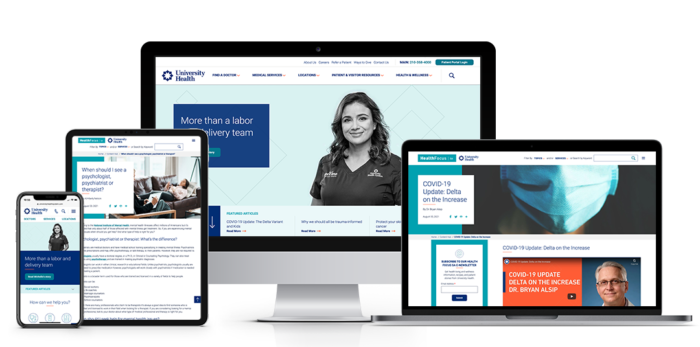
PIH Health
PIH Health, in Whittier, California, launched a new website that delivers its reimagined web presence to ensure the site tells a system-centric story in a consumer-friendly way.
The site, built on VitalSite, won:
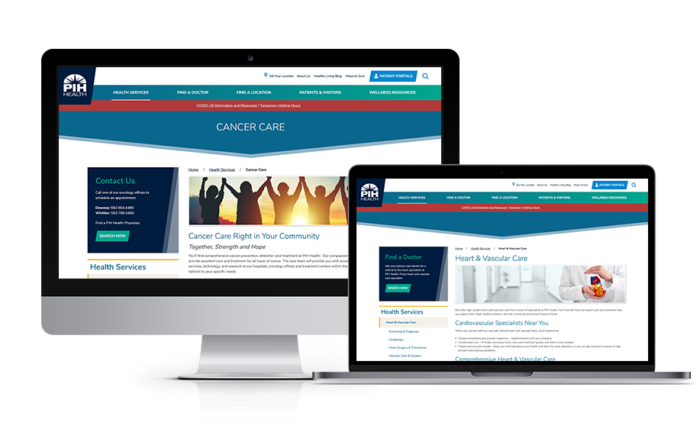
EvergreenHealth
EvergreenHealth, in Kirkland, Washington, launched a new website with a data-driven strategy to meet the unique needs of their tech savvy community.
The site, built on VitalSite, won a MarCom Award for Website – Medical, Gold.
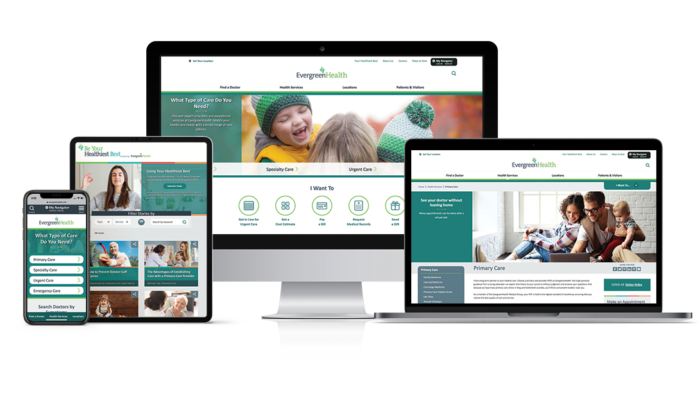
Acclaim Physician Group
Acclaim, in Fort Worth, Texas, launched a new website that makes it easier for patients to find a provider using a new content management system (CMS).
The site, built on VitalSite, won a eHealthcare Leadership Award Winner for Best Site Design, Platinum.
In 2020, Acclaim received an honorable mention from the MarCom competition in the Website – Medical category.
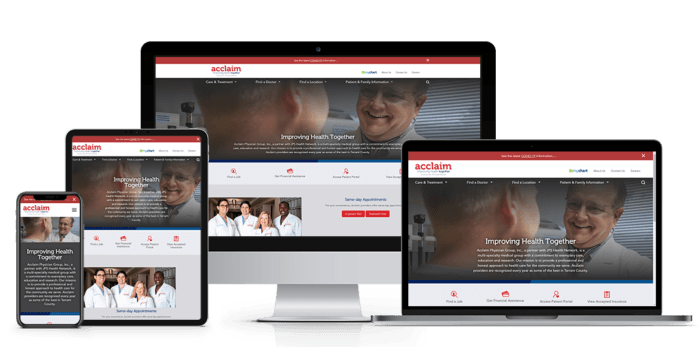
Fisher-Titus
Fisher-Titus, in rural Ohio, launched a new website with a modern design, improved navigation that helps site visitors easily navigate and understand the breadth of health services available throughout the Fisher-Titus medical center.
The site, built on VitalSite, won:
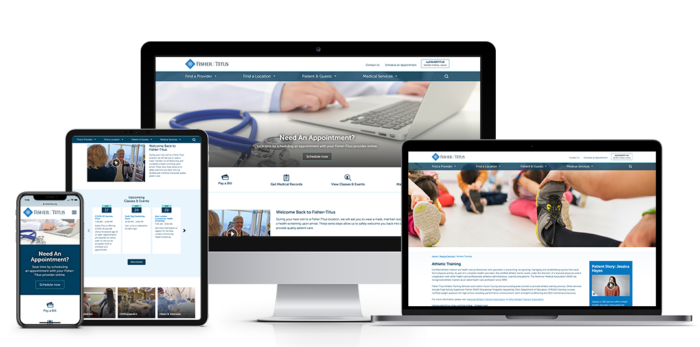
Virginia Hospital Center
Virginia Hospital Center, in Arlington, Virginia, launched a new website to deliver a new responsive design and sitewide navigation with healthcare-specific functionality to make it easier to search for and select providers, locations, classes, and services.
The site, built on VitalSite, won:
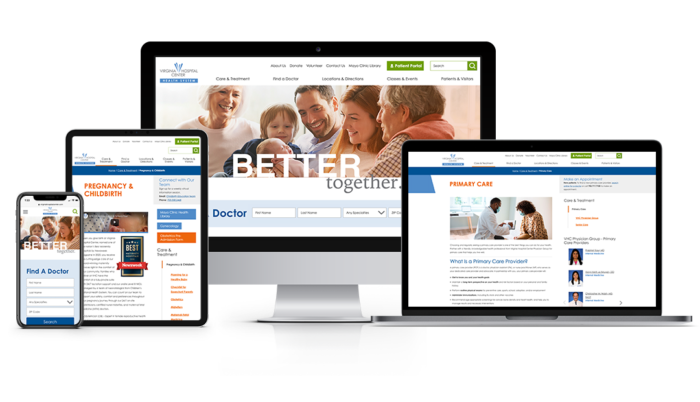
Avera
Avera, in Sioux Falls, South Dakota, launched a new foundation microsite and Intranet that were both user-centric and leverages the strength of their brand.
The intranet, built on VitalSite, won:
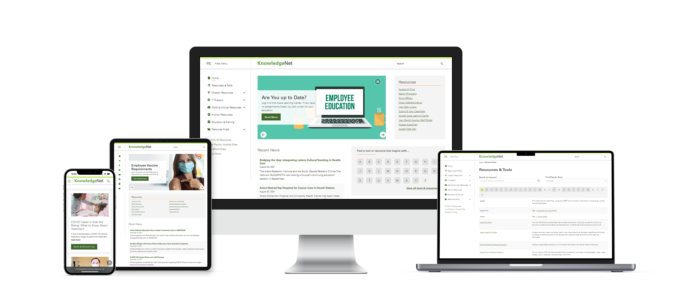
The foundation microsite, also built on VitalSite, won:
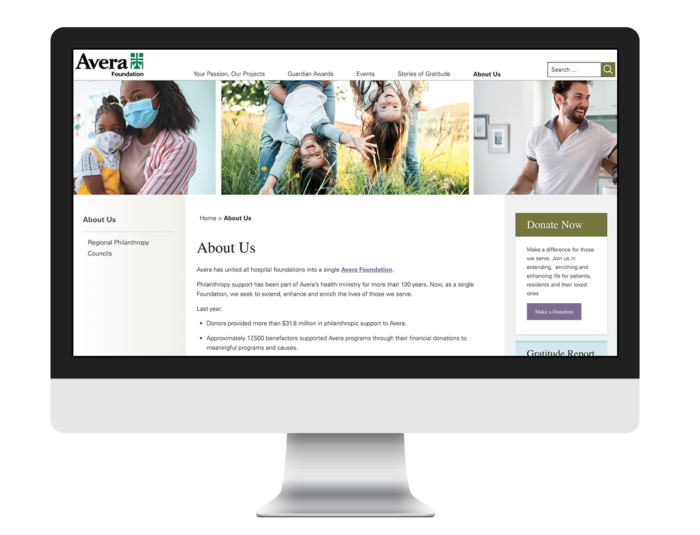
Mary Greeley Medical Center
Mary Greeley Medical Center in central Iowa, launched a new microsite for its William R. Bliss Cancer Center to strengthen the brand and highlight its differentiators when it comes to cancer care.
The site, built on VitalSite, won:
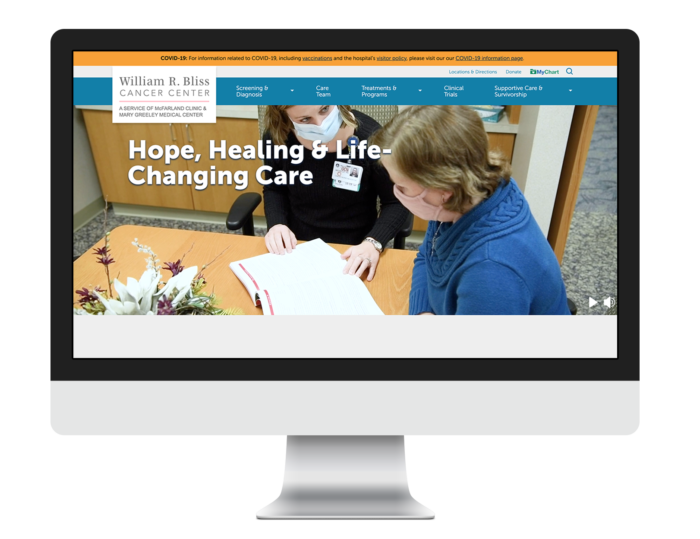
Montage Health
Montage Health, in Monterey, California, launched a new website to enhance their digital presence to strengthen their brand as an innovative health and wellness system.
The site, built on VitalSite, won:
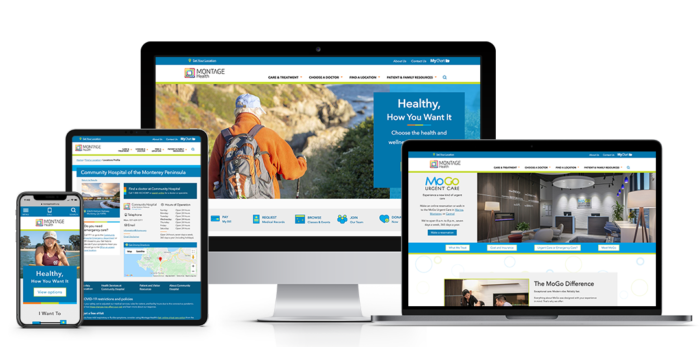
Ozarks Healthcare
Ozarks Healthcare, in West Plains, Missouri, launched a new website to create an inviting, easy-to-navigate website that communicates the full continuum of care and medical services.
The site, built on VitalSite, won a MarCom Award for Website – Medical, Gold.
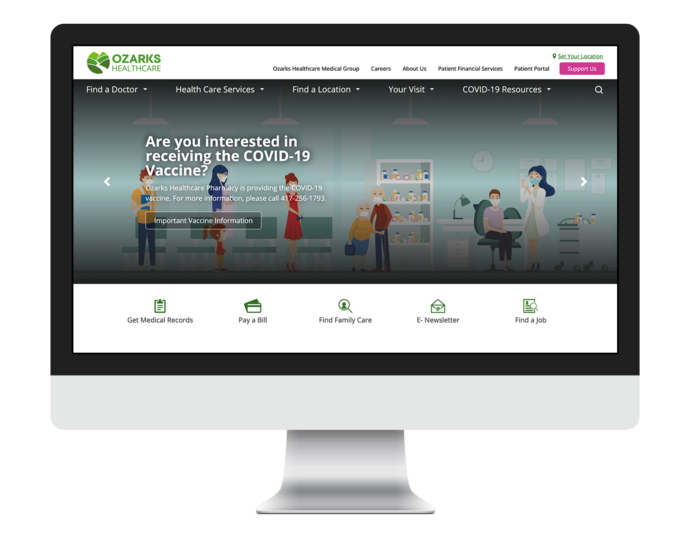
2020 Award-Winning Healthcare Websites
Streamlined designs, a focus on user experience, and improved functionality– particularly around the provider directory, are common features in many of 2020’s winners. Check out some of 2020’s best healthcare websites.
ProHealth Care
2020’s big winner was ProHealth Care. Headquartered in Waukesha, WI, ProHealth Care’s new site is built on Geonetric’s VitalSite, boasts a new, streamlined design and improved navigation, and was WCAG 2.0 accessible at launch.
The site took home many awards in 2020, including four from eHealthcare Leadership Awards: Platinum award for Best Site Design, gold award for Best Overall Digital Experience, gold award for Best Doctor Directory, and silver award for Best Internet Home Page. The site also received a gold award in the MarCom awards in the Website -Medical category.
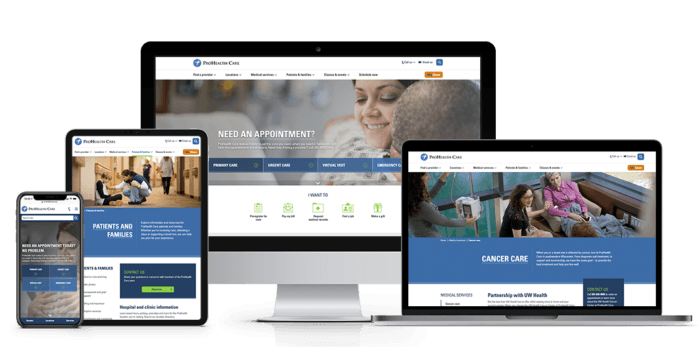
Silver Cross Hospital
Silver Cross Hospital, New Lennox, IL, consolidated numerous sites into one, built on the VitalSite content management system (CMS). With a pre-built theme as the foundation, the site was quicker to launch while still benefiting from decades of design, development, information architecture, and content strategy best practices. The theme is responsive, fast-loading, and accessible. The selected theme was modified to support Silver Cross Hospital’s unique brand and approach to care.
The site took top honors in the MarCom competition with a platinum award. It also received a silver award in Best Site Design in the eHealthcare Leadership Awards.
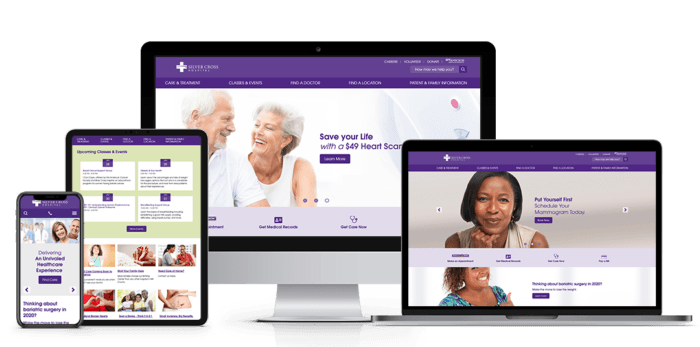
East Tennessee Children’s Hospital
Headquartered in Knoxville, TN, East Tennessee Children’s Hospital is the only regional pediatric center in Tennessee accredited by the Joint Commission. Built on VitalSite CMS and showcasing a unique, custom design with detailed illustrations, East Tennessee Children’s Hospital’s new site engages site visitors with an intuitive user experience and improved functionality, becoming a celebrated new digital front door for the organization. The design also features custom graphics that bring unique artwork from inside the hospital to life on the website. The site received an honorable mention award from the MarCom competition in the Website-Medical category.
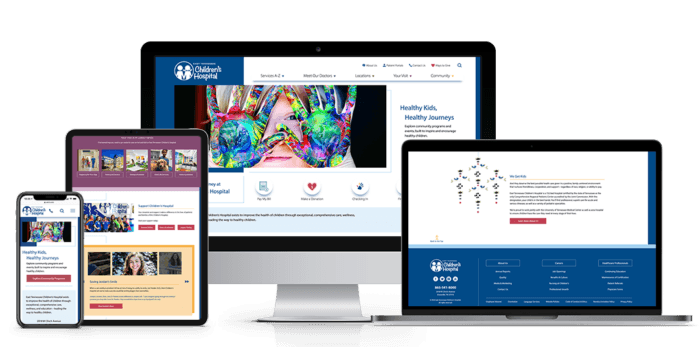
Grand River Medical Center
After recent mergers, Grand River Medical Center in Dubuque, IA needed a new website. The new site is built on VitalSite Essentials, a CMS platform developed with medical groups in mind — and improves the medical centers’ mobile experience with a responsive design. In addition, the site has an improved search and navigation, an updated provider directory, new user-focused content, and eye-catching calls to action. Grand River Medical Center’s site received an honorable mention award from the MarCom competition in the Website-Medical category.
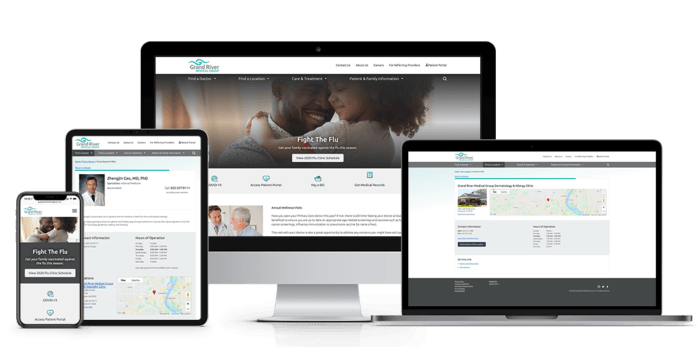
Ridgeview
Ridgeview is an independent, nonprofit, regional health care system serving the southwest metro region of the Twin Cities. Ridgeview’s new site is built on VitalSite and boasts a high-quality digital experience that is consumer-focused and user-friendly for all audiences across the Ridgeview system. The new navigation makes it easier for consumers to find services and resources. The site received a gold award from the MarCom competition in the Website-Medical category.
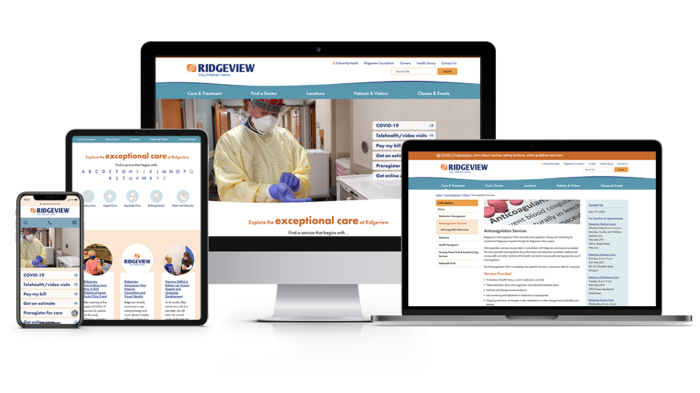
Mary Greeley Medical Center
Headquartered in Ames, IA Mary Greeley Medical Center is a 220-bed regional hospital that provides healthcare to residents in 13 counties. The new website is built on VitalSite and delivers an updated, modernized experience with dropdown navigation menus with icons. Through a hero video, eye-catching icons, and large fonts, the homepage highlights patient care, patient stories, and promotes the First Nurse Call Center. The site received an honorable mention award from the MarCom competition in the Website-Medical category.
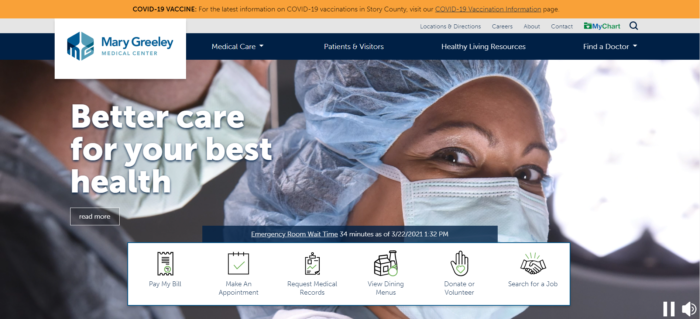
Pacific Diagnostic Laboratories
Pacific Diagnostic Laboratories (PDL) needed a new web presence that offered a more robust location directory, engaging, patient-focused content, and made it easy for the PDL team to keep the site up-to-date. The Santa Barbara, CA-based organization worked with Geonetric to design and develop a more modern site on the VitalSite content management system. New navigation and content are audience-focused, and the site’s new location directory delivers important information to site visitors. The site received a gold award from the MarCom competition in the Web Element-Microsite category.
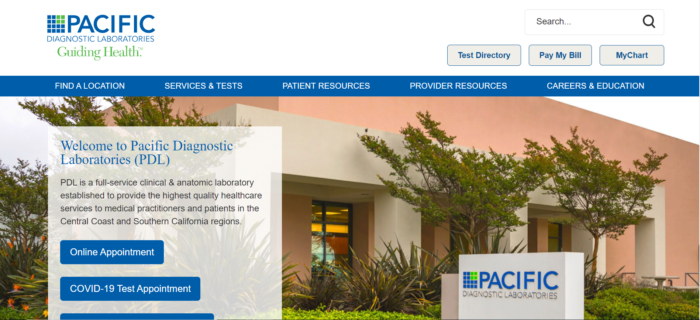
2019 Award-Winning Healthcare Websites
From journey maps to user research to accessibility, big winners from 2019 tackled important initiatives with their websites. Check out some of 2019 best healthcare websites.
Cone Health
Cone Health, headquartered in Greensboro, NC, launched a new site that remained true to their patient-focused values. Cone Health invested in research to better understand how users interacted with their website before the redesign as well as during development—which paid off exponentially. The site seamlessly integrates their access to care initiatives into the homepage banner, guiding users as they explore traditional and new care options.
The site, built on VitalSite, took home many of the industry’s biggest honors, winning Website of the Year from Modern Healthcare, platinum for Best Internet Homepage in the eHealthcare Leadership Awards, and was a finalist for Ragan’s Health Care PR and Marketing Awards. In addition, Cone Health’s site also took come gold in the MarCom awards in the Website-Medical category.
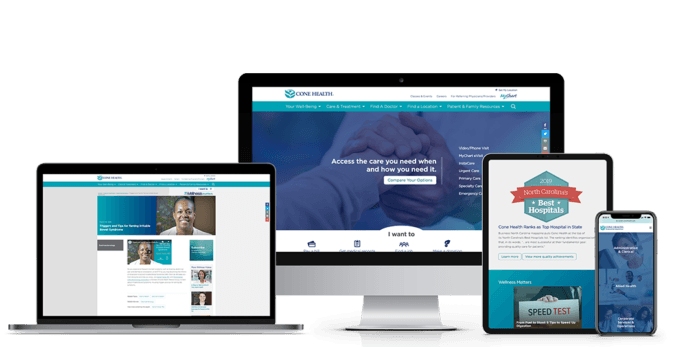
Cape Cod Healthcare
Cape Cod Healthcare in Hyannis, MA launched their new site in January of 2019. The organization invested in user research and took particular care with integrating their popular content marketing hub into the new, redesigned site built on the VitalSite platform.
The site immediately started winning awards, including Best Redesign from HITMC, silver award for Website Campaign of the Year from Modern Healthcare, distinction for Best Overall Internet in the eHealthcare Leadership Awards, platinum from MarCom in the Website-Medical category, and was a finalist for Ragan’s Health Care PR and Marketing Awards.
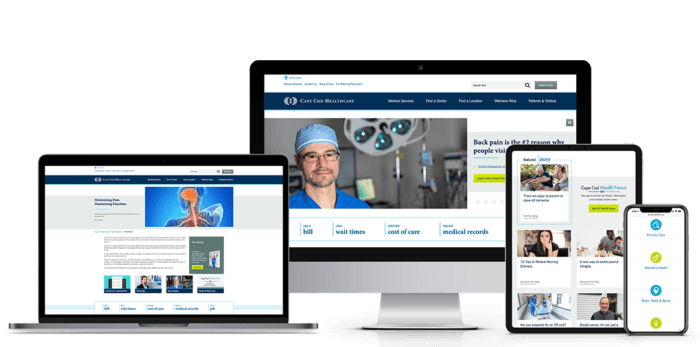
Adventist HealthCare
Headquartered in Gaithersburg, MD, Adventist HealthCare launched their new website in February 2019 on the VitalSite content management system (CMS). A patient journey approach was applied to every element of the redesign project, driven by content strategy and content development efforts that prioritized usability, conversions, and Adventist HealthCare’s brand.
The site took home impressive honors including platinum for Best Interactive and Best Internet Homepage in the eHealthcare Leadership Awards, honorable mention from MarCom in the Website-Medical category, and was a finalist for Ragan’s Health Care PR and Marketing Awards and HITMC’s best redesign.
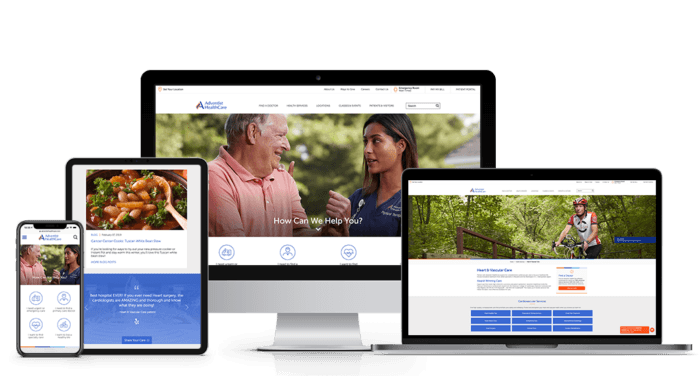
North Mississippi Health Services
North Mississippi Health Services includes community hospitals in six locations throughout north Mississippi and northwest Alabama, as well as a network of more than 45 primary and specialty clinics. The organization launched a new website on VitalSite that offers a patient-friendly experience, makes it easier to interact with the organization, and presents a unified presence for the system.
The system won two prestigious awards, including gold for Best Site Design from eHealthcare Leadership Awards and gold from MarCom in the Website-Medical category.
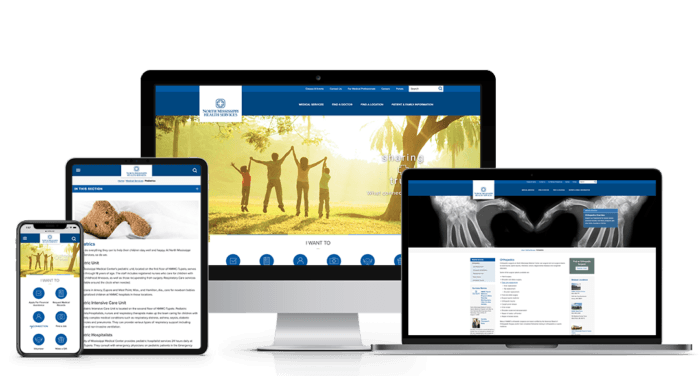
LMH Health
Having just rebranded from Lawrence Memorial Hospital to LMH Health, the Lawrence, KS-based health system launched a new website on the VitalSite CMS that demonstrated the breadth and depth of their expanded system.
The new site took home three impressive awards, a platinum in the Best Internet Homepage category and a silver in the Best Doctor Directory category, both at the eHealthcare Leadership Awards. The site also won a gold from MarCom in the Website-Medical category.
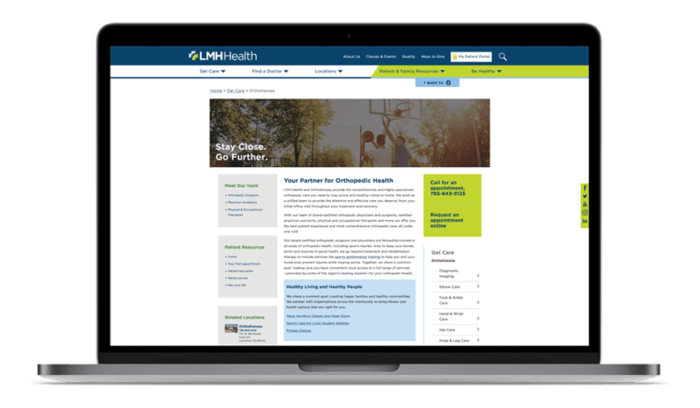
MaineGeneral
MaineGeneral, Augusta, GA, launched a new site that presented a more unified system-centric approach to site visitors, improved functionality, and created more patient-friendly content.
The new site, built on VitalSite, received an honorable mention in the MarCom awards in the Website-Medical category.
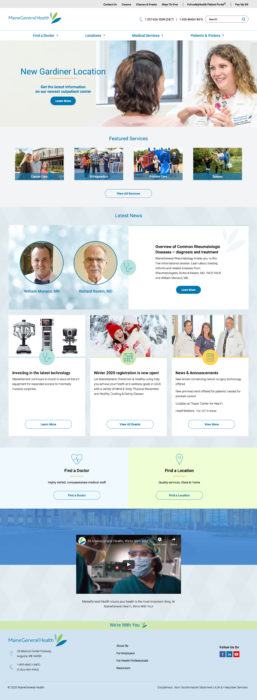
Olmsted Medical Center
When Olmsted Medical Center (OMC), Rochester, MN, set out to redesign their website, they had traditional redesign goals like improving navigation and making the site more user-friendly and more mobile-friendly. The organization also had another, less-traditional goal: make life easier for the individual who manages all aspects of OMC’s website.
Built on VitalSite, their new site meets all those goals and took home an honorable mention at the MarCom awards in the Website-Medical category.
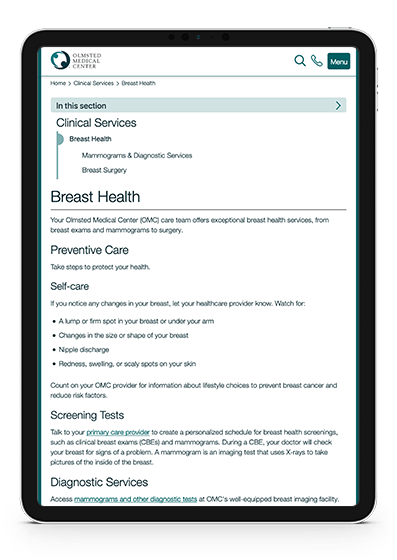
Pella Regional Health System
Headquartered in Pella, IA, Pella Regional Health System took a mobile-first approach to their new site to meet the needs of their growing mobile audience.
The new site received an honorable mention in the MarCom awards in the Website-Medical category.
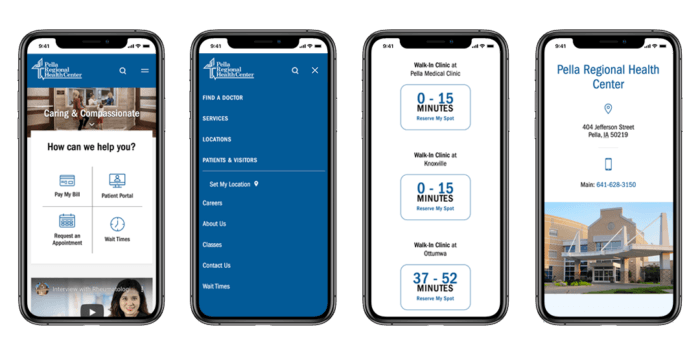
2018 Award-Winning Healthcare Websites
Each year hospital websites launch that take user experience to new levels, whether through design, content, or functionality. Check out some of 2018’s top performers.
Essentia Health
Essentia Health, headquartered in Duluth, MN, launched their new site in May of 2018 with a mobile-first design and industry-leading functionality that includes open scheduling for new patients and ER and urgent-care scheduling and wait times.
The site immediately started taking home top accolades from some of the most prestigious competitions in the healthcare industry. Essentia was recognized by Ragan’s Health Care PR and Marketing Awards as a finalist for their Website Launch or Relaunch of the year. This awards program seeks out the innovators in the industry and found one with Essentia.
Their website, built on the VitalSite® content management system (CMS), received a sought-after Modern Healthcare IMPACT Award, taking home gold for Website Campaign of the Year.
And finally, Essentia received platinum in the Best Overall Internet Site category at the eHealthcare Leadership Awards, which are given out every year during Greystone.Net’s Healthcare Internet Conference.
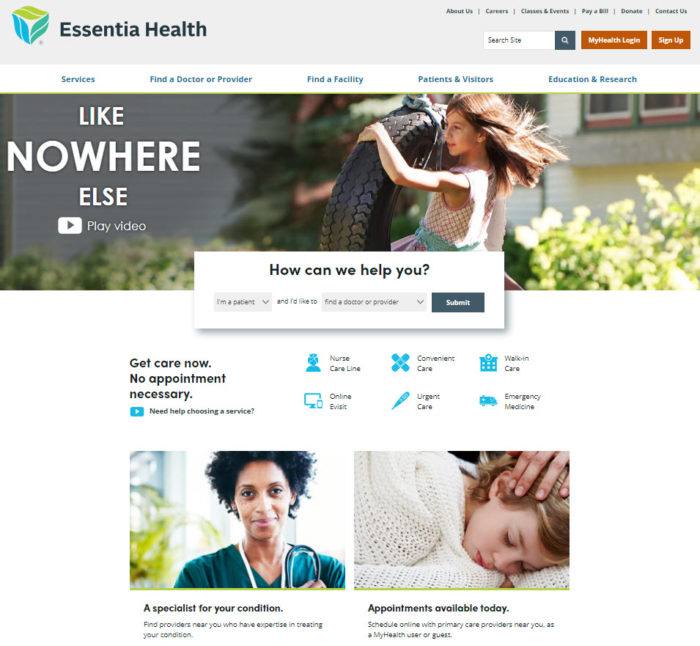
Firelands Regional Health System
Firelands Regional Health System, Sandusky, OH, redesigned with the hope of presenting a more consolidated brand experience to the market, as well as to move to VitalSite, a more user-friendly CMS. They didn’t set out to win awards, but with their new responsive site and integrated blog, that’s just what happened.
Firelands took home a Best in Class at the Interactive Media Awards, the highest honor bestowed by the organization. The site also received a silver for .
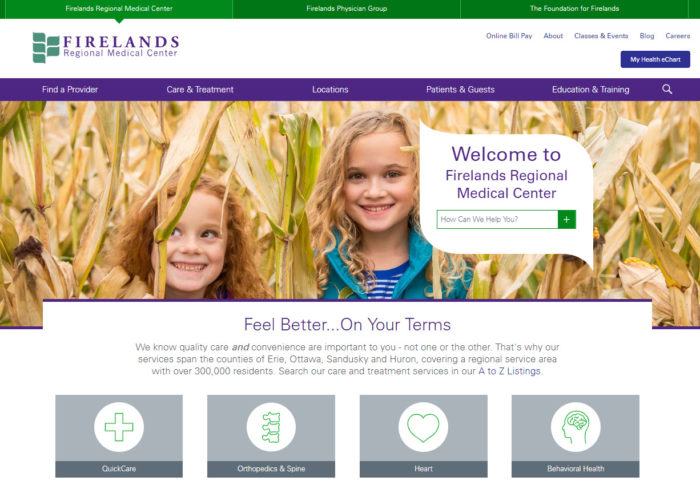
Mercy Medical Center
When Mercy Medical Center, Cedar Rapids, IA, redesigned their site in 2018, they employed user testing and heatmap analysis to drive redesign decisions and help them use the web to grow traffic to new and existing services with a focus on promoting urgent cares.
The prelaunch efforts paid off as Mercy took home two top honors, including a Best in Class from the Interactive Media Awards and platinum for Best Site Design at the eHealthcare Leadership Awards.
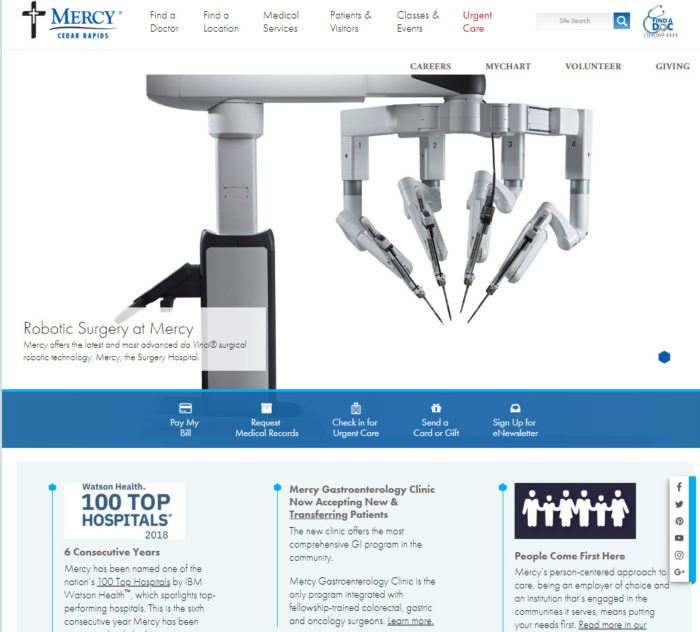
Sturdy Memorial Hospital
Sturdy Memorial Hospital, Attleboro, MA, needed to consolidate numerous microsites into one responsive site that offered improved functionality. And, they needed all this to be built on a more user-friendly CMS.
With their redesign, they achieved all of that and more, winning a 2018 Lamplighter Award from the New England Society for Healthcare Communications and an Outstanding Achievement from the Interactive Media Awards. In addition to the overall redesign, it was important to Sturdy Memorial to create a flexible landing page to use for campaigns — and that landing page went on to win an Honorable Mention in the MarCom Awards.
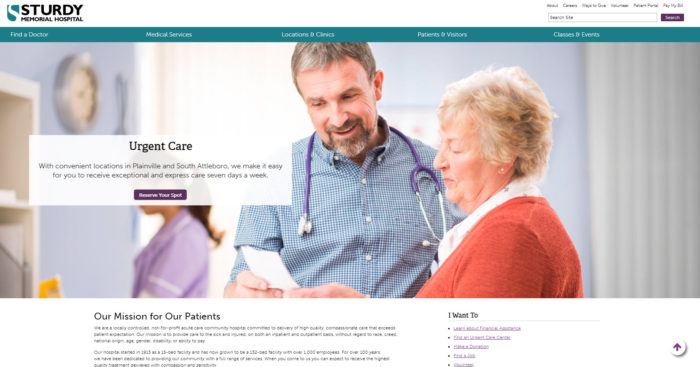
Stamford Health
With the goal of presenting a more unified system presence, Stamford Health’s new site streamlines Stamford Hospital, Stamford Health Foundation, and Stamford Health Medical Group content areas, improving navigation and the overall user experience.
The site delivers a modern feel with patient-centered photography and the home page took home platinum for Best Internet Home Page from the eHealthcare Leadership Awards.
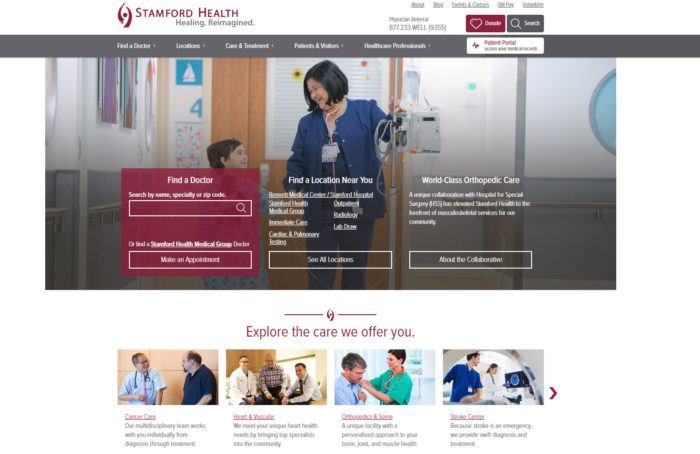
Tower Health
Reading Hospital set out on a website redesign to align their doctors, locations, and brand — and they wanted a CMS that gave them room to grow. Everything was progressing well, and then right before launch, the organization acquired five community hospitals. Reading Hospital became Tower Health and they needed to update the site quickly — and thanks to the flexible design and navigation it was easy.
The new, consolidated site went on to win a Best in Class from the Interactive Media Awards.
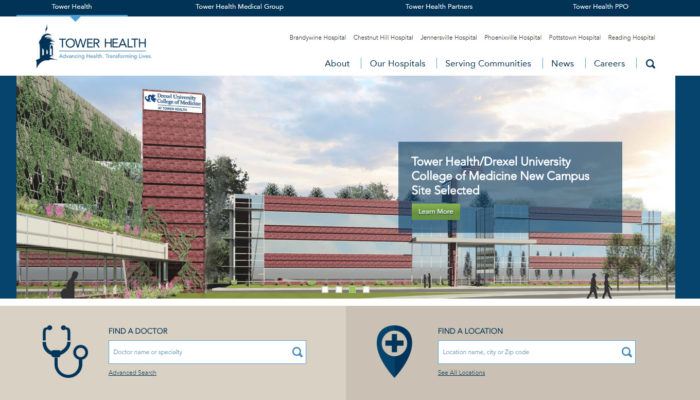
Gundersen Health
An early mover in the content hub space, Gundersen Health, La Crosse, WI, redesigned their wellness hub in 2018 to refresh the design, add social sharing functionality, better incorporate video, and use panels to feature news and better promote providers. The new health and wellness hub is a hit with users as well as judges, with the site taking home a gold in the Digital Medical Website category of the MarCom Awards.
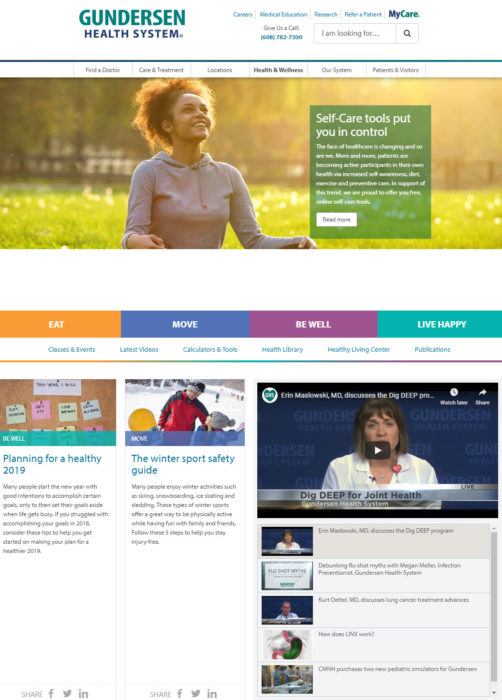
Genesis Health
Looking to promote their BirthCenter, Genesis Health, headquartered in Davenport, IA, created a landing page that shares family stories and lets site visitors take a virtual tour or create a birth plan. The landing page also promotes the organization’s expert staff and has fun interactive features and information, including the 2018 top Genesis baby names. The landing page received an Honorable Mention in the landing page category of the MarCom Awards.
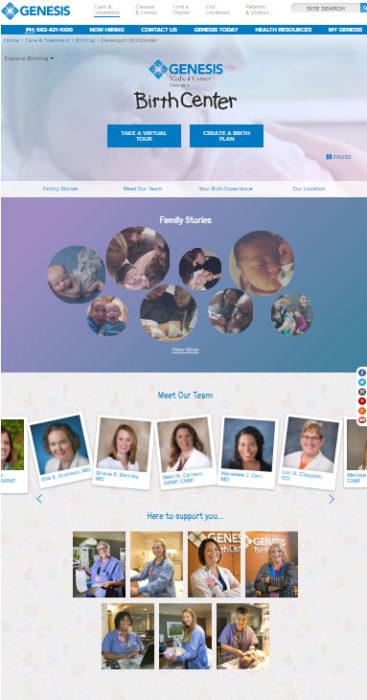
Altru Health System
Altru Health System, located in Grand Forks, SD, was one of the first hospital websites to go responsive in 2013 and took that dedication to exceptional mobile experiences to a new level with their 2018 redesign. The new site features flyout menus and integrates their blog feed into the homepage and service-line pages. The site took home a gold in the Digital Medical Website category at this year’s MarCom Awards.

2017 Award-Winning Hospital Websites
Avera Health
Avera, headquartered in Sioux Falls, SD, has a storied history of creating award-winning marketing and design. And 2017 was a great year for their team.
They were the recipients of the prestigious Modern Healthcare IMPACT Award. This award recognizes outstanding healthcare marketing campaigns that are reinventing the way audiences receive and retain healthcare information. This year, they honored Avera Health with the award for Website Campaign of the Year for their main website, which is built on the content management system, VitalSite. The MarCom award competition also took note of their site, and awarded the organization a Gold in the medical category for their website.
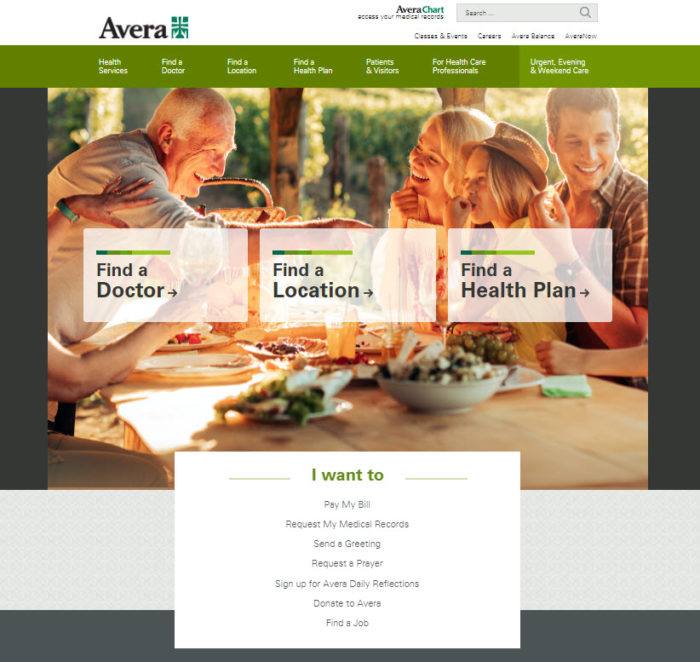
This year the team invested in a new online hub to enhance their content marketing efforts and improve SEO. Site visitors aren’t the only ones who love this content marketing hub, it took home a Platinum award for Best Social Network from the eHealthcare Leadership Awards, which were awarded at the 21st Annual Greystone.Net Healthcare Internet Conference in Austin, TX.
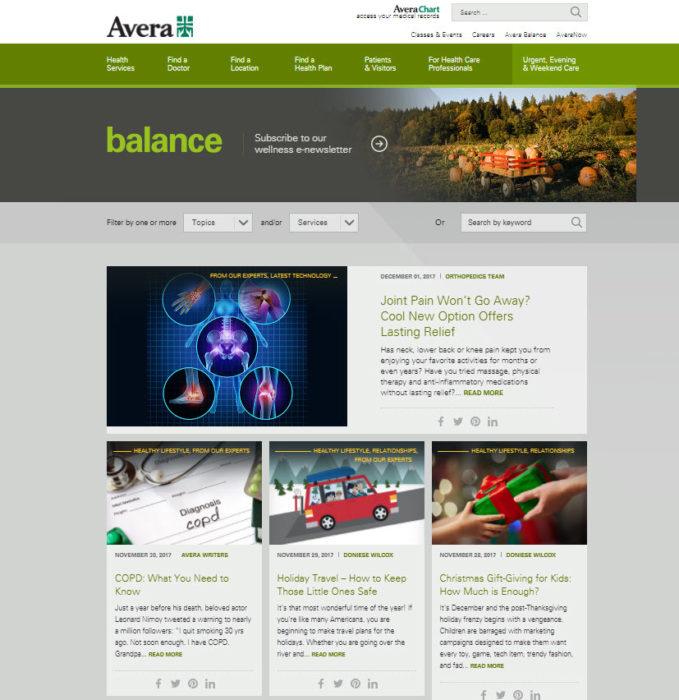
Gundersen Health
Based in La Crosse, WI, Gundersen Health serves patients in 19 counties across three states. They recently launched a new system-centric site and rolled numerous microsite into one, responsive health system site.
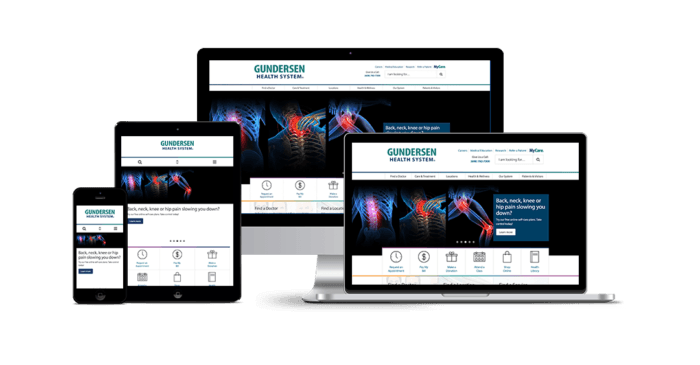 Their site visitors aren’t the only ones that have noticed how impressive the new site is. The site took home a Best in Class accolade at the 2017 Interactive Media Awards.
Their site visitors aren’t the only ones that have noticed how impressive the new site is. The site took home a Best in Class accolade at the 2017 Interactive Media Awards.
In addition to the overall site, Gundersen Health created custom provider profiles with ratings and reviews to help site visitors connect and engage with their more than 1,000- high-quality doctors. The system’s provider directory recently took home a Distinction for Best Doctor Directory from the eHealthcare Leadership Awards.
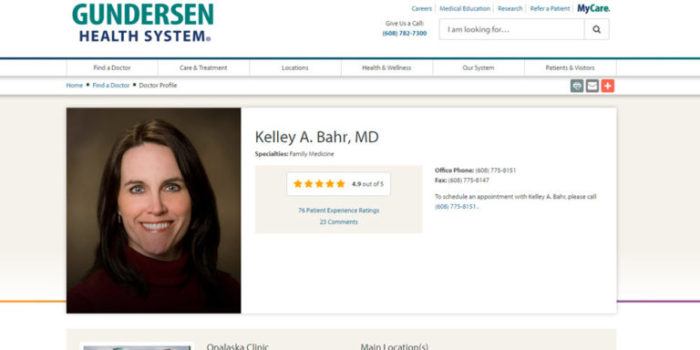
Spartanburg Regional Healthcare System
Prior to redesigning their homepage, Spartanburg Regional Healthcare System worked with our team to do some digging into user statistics. Using scroll mapping and heat mapping, they identified numbers areas for improvement, particularly around main and secondary navigation. They also found places to improve page load and site speed as well as adding more strategic calls to action.
The result? A new homepage that is visually engaging and user-focused. Since launching the new homepage design, Spartanburg Regional is enjoying decreased bounce rates and increase in mobile site visitors. And, they recently took home a Silver for Best Internet Homepage from the eHealthcare Leadership Awards.
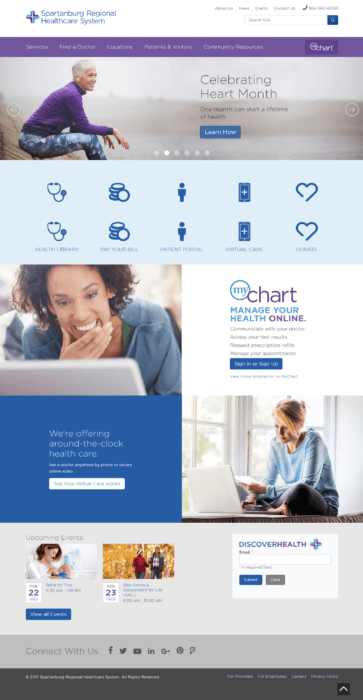
Cone Health
With an organizational focus on enhancing their content marketing efforts and embracing the “create once, publish everywhere” mantra, Cone Health reached out to their digital partner to help them create a new content hub. Branded Wellness Matters, the hub showcases many different content types, including videos, blog posts, and testimonials. Built in their healthcare-specific CMS, it also has a sophisticated taxonomy structure that allows it to filer by topic and content type. It also includes SmartPanels that pull in social media feeds. The hub received a Gold from the MarCom Awards.
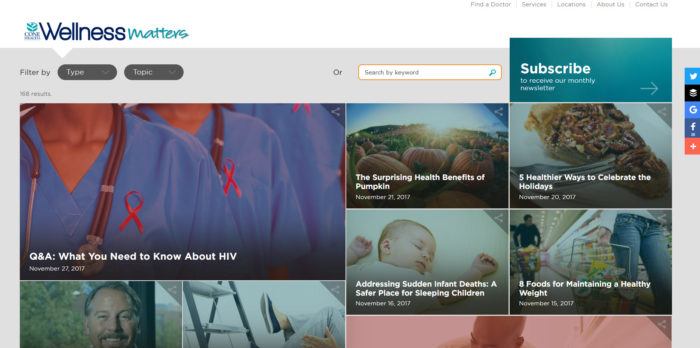
UNM Health System
Previously UNM Health System, associated with the University of New Mexico Health Sciences Center (UNM HSC), maintained separate websites for UNM Hospital, UNM Sandoval Regional Medical Center, UNM Medical Group, and other health care entities. Some sites had minimal information architecture and inconsistent navigational menus that could leave users feeling lost. And none of the sites referenced UNM Health System, a newly branded system.
That’s why they worked with us to create a new, responsive site offering a clear, consistent information architecture that makes the site easy for users to navigate and for the UNM HSC web team to manage. Creating a single, new website also provided an opportunity to rewrite and develop user-friendly content.
The new site received a Distinction at the 2017 Interactive Media Awards. The site’s new user-focused content didn’t go unnoticed either, receiving an Honorable Mention in the Web Content category at the MarCom awards.
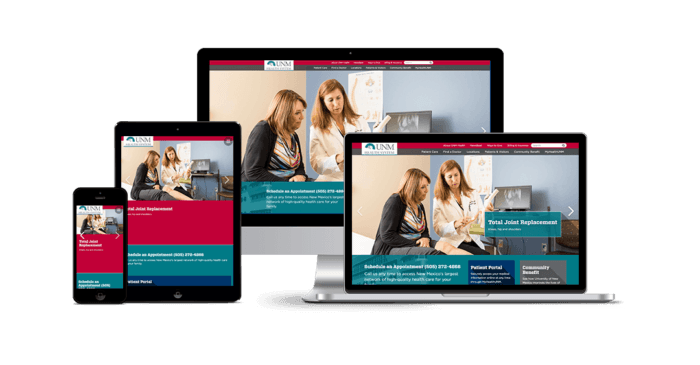
Rutland Regional Medical Center
Rutland Regional Medical Center is a regional system located in rural Vermont. The health system hadn’t redesigned in four years and was ready to modernize the site design and go responsive. The new, responsive site offers large hero images, clean navigation, and clear bold calls to action. It received a Distinction at the 2017 Interactive Media Awards.
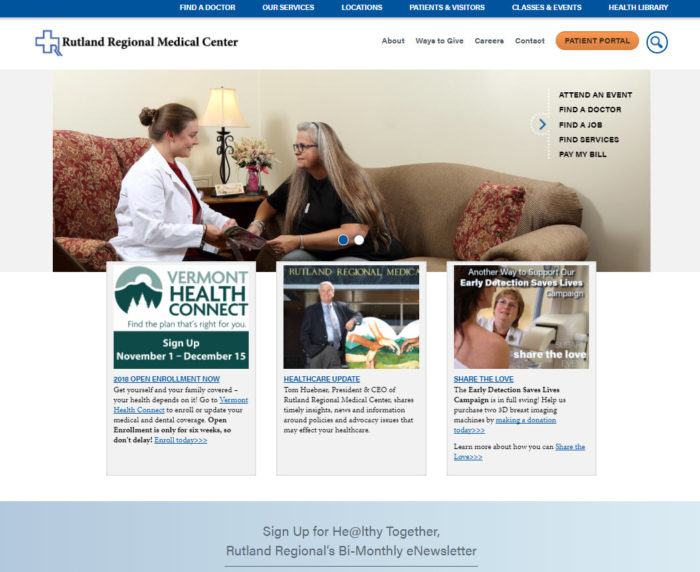
UNC Physicians Network
UNC Physicians Network turned to us to develop a site that builds off of the already established digital foundation for UNC Health but gives their more than 50 practice locations a dedicated area for their story. The site received an Honorable Mention in the medical category of the MarCom awards.
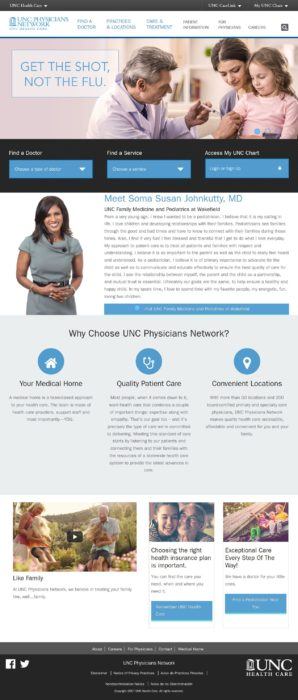
Adventist Medical Group
How to brand a medical group is a top question facing many healthcare marketers today. For one award-winning example, check out Adventist Medical Group. The site features engaging provider profiles and custom location pages. The medical group also worked with us to create user-focused service line content. The site received an Honorable Mention in the medical category of the MarCom awards.
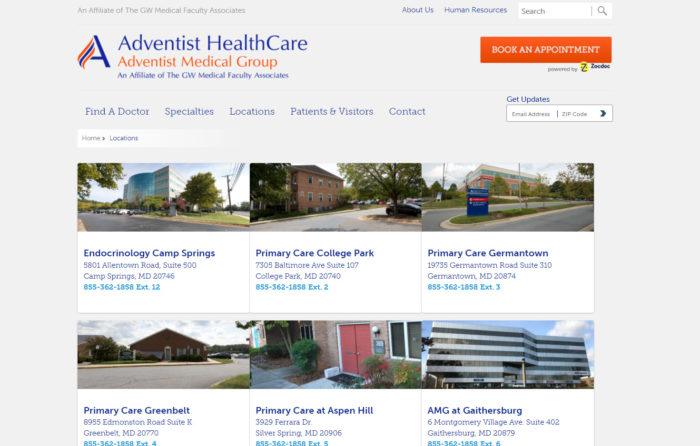
Asante
Blogging is a popular way to engage your target audience and help search engine rankings at the same time. Asante launched a blog to share special moments, health tips, and recipes with their Medford, OR community. The MarCom awards were impressed, giving Asante a Gold in the Social Media category.
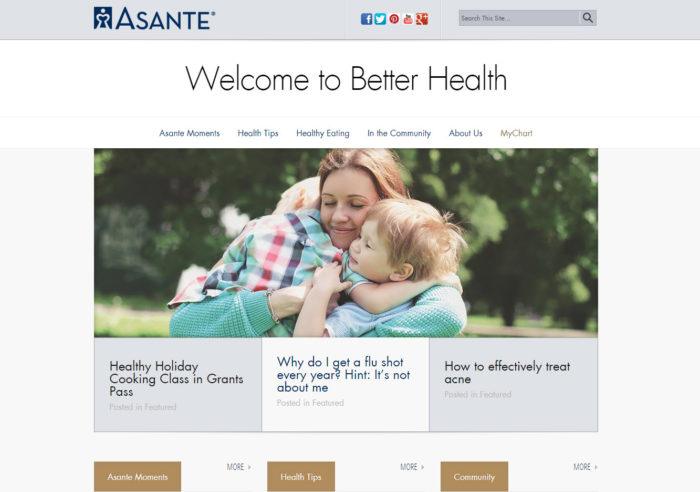
Award-winning design and development for healthcare
Award-winning web design and development is about more than just using eye-catching imagery or the latest trends in rollover effects. All of these healthcare organizations worked with Geonetric to ensure their sites not only bring their brands to life online but have a strong technical foundation that takes everything from accessibility to page load speed into consideration.
Ready to start your next award-winning project? Questions about anything you’ve seen here? Drop us a line. We love talking shop.
